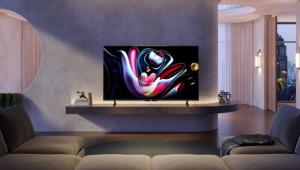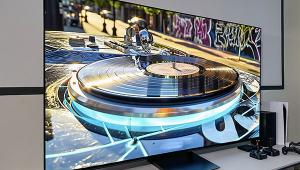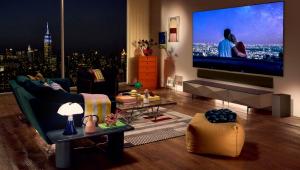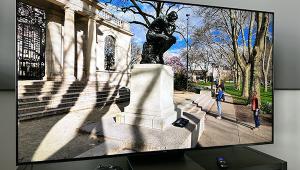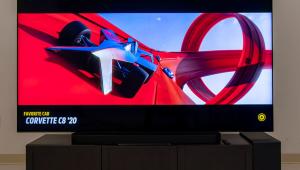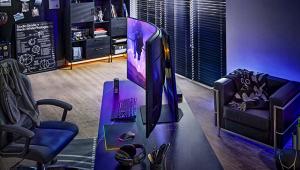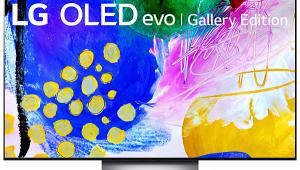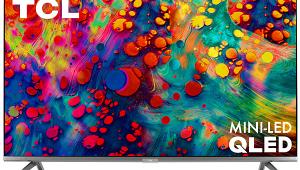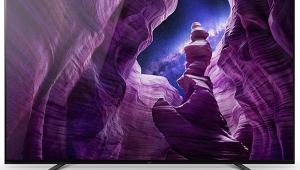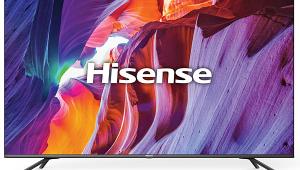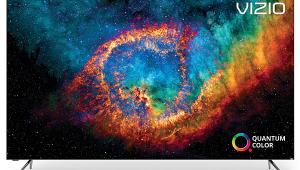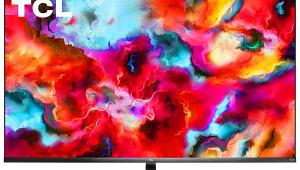The C7P undercuts the Sony by $1000 and bests it in black level and shadow detail.
Sony XBR-65A1E OLED Ultra HDTV Review Test Bench<
Measurements were made using SpectraCal’s CalMAN software, Photo Research PR-650 and Klein K-10A color meters, and AVFoundry (VideoForge, for 2K) and Murideo/AVPro (Fresco Six-G, for 4K/HDR) pattern generators.


1080p/SDR
Full-On/Full-Off Contrast Ratio: 143,000:1
In the Cinema Pro Picture Mode, with the Black level control on 50, the Brightness (backlight) on Max, the Contrast on 95, the Gamma at –2, and an 18% full white window, the measured peak white level was 42 foot-lamberts or 143 nits (all peak white level values here and below rounded off to the nearest nit/ft-L). A full black screen with a white pause bug displayed in the corner of the screen, measured 0.001 nits. Given the possible tolerances of our Klein color meter, this might well have been 0.000 nits, but we’ll call it 0.001 to be conservative!
In the Expert 1 Color temperature and the above settings, modified only by reducing the Contrast control from its default setting of Max for a reasonable peak white level of 42 ft-L, the pre-calibration grayscale Delta E from 20% to 100% varied from a minimum of 1.68 at 20% to 4.91 at 100%. Post-calibration, using only the 2-point grayscale controls, the Delta Es varied from a minimum of 0.16 at 20% to 0.9 at 70%. Though the A1E offers no color management system, the post- calibration color Delta Es varied from a minimum of 0.7 (blue) to a maximum of 1.72 (red).
(Delta E is a figure of merit indicating how close the color comes to the D65 HD standard at each point in the brightness range. Values below 3—some experts allow for 4—are generally considered visually indistinguishable from ideal. Above 4 but less than 10, the colors will be visibly changed but generally in ways unobjectionable to the average viewer.)
With the Gamma control set to –2, the Sony’s 1080p/SDR gamma ranged from a high of 2.46 at 90% to a low of 2.37 from 30% to 40%.
UHD/HDR
Full-On/Full-Off Contrast Ratio: 632,000:1
In the Cinema Home Picture Mode, with the Black level control on 50, the Bright- ness and Contrast on Max, the Gamma at +2, and the other settings left in the defaults for that mode, a 100% brightness signal covering 10% of the screen measured 632 nits. A full black screen with a white pause bug displayed in the corner of the screen measured 0.001 nits, at worst, for the full-on/full-off contrast ratio shown above.
As with all OLEDs, the peak white output, particularly in HDR, varies considerably with how much of the screen is producing that peak white. With a 100% white source covering 2% of the screen (a 2% window), the screen brightness measured 633 nits; with a 10% window, as above, 632 nits; with a 25% window, 298 nits; and with a 100% (full screen) window, 144 nits.
In the default Cinema Home settings, the pre-calibration grayscale Delta E from 20% to 100% varied from a minimum of 0.7 at 20% to 6.5 at 70%. Post-calibration, using only the 2-point grayscale controls and advancing the Gamma control to +2 (the effect of the Gamma control on the gamma or, in this case, the PQ curve, is discussed in the text), the Delta Es varied from a minimum of 1.3 at 20% to 5.1 at 70%. Though there’s no color management system here, the post-calibration color Delta Es varied from a minimum of 2.0 (cyan) to a maximum of 3.5 (red). Note that the Delta E values for HDR include not only the position of the measured point within the color gamut, but its luminance as well.—TJN
- Log in or register to post comments


Touching the Bias settings apparently has the side effect of elevated black levels according to a few that have tinkered with the calibration far more extensively.
When done properly this part of the equation is already a non-factor. Secondly the gamma is elevated on the Sony by design in the lower regions precisely to give more shadow detail.
And of course the sky is not truly black (when viewed from earth) :D

The problem with OLED models is price cost.
LG moved their C6 and B6 2016 model OLEDs when they cut their price to $3,000. 2017 C7 and B7 models are now competitively price with LED's, at least up to 65"screen size.
Sony just won't move enough of their A1E OLEDs at $4,200.
Personally I prefer Sony's 940E 75"screen size to any 65"OLED.
With the right 4k content the 940E wows. At a street price of $4,200 is a bargain.
Yes the 77" OLED's are visually mesmerizing but their cost (10,000 for LG and $18,000 for Sony) puts them in competition with 4k Projectors (Sony, Epson, JVC, Optoma) that can produce stunning images in 130+"screens.

I hear so many people complaining about the price of OLED TVs (and I agree that Sony seems to be overpricing their models as compared to the ones from LG), but many of these same people wax nostalgic about the bygone Pioneer Kuro Elite plasma TVs from a few years back (and they were beautiful TVs, BTW). But they seem to have forgotten that the pioneer Elite Kuro Pro-151FD 60" beauty had a MSRP of $5800 in 2009. No streaming. No 4K. No HDR or Dolby Vision. I'll bet that list price is at least $6500 after inflation in 2017. You can get a pretty sweet LG E7P with all the bells and whistles you need for about $3500 today.
As I have said: I am not trying to put down the plasmas; they were spectacular televisions, the supreme TVs of their time. But people have very selective memories about things like price. Don't forget, in the late '70s a top-of-the-line VHS VCR could run you nearly $1000!

